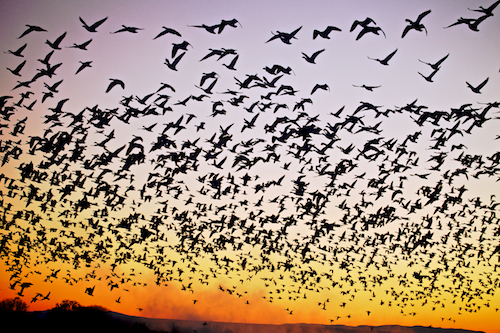
Since this was my first time there, I decided to participate in a photography workshop with seasoned veterans (Rick Sammon and Juan Pons) who knew their way around the preserve as well as a camera - and they most certainly did not disappoint!
Our workshop began on the evening of December 5th and the weather was a real challenge - 8" of snow at the beginning on the week and below zero temperatures for the rest of it. Juan and Rick were determined not to let the weather deter us and found new and interesting places to shoot for the first day and a half (when Bosque was actually closed due to the weather) The alternate sites were fun and full of adventure but most importantly, the guys kept it very upbeat and interesting. Once we were able to enter Bosque, we were treated to a true winter wonderland, with Juan scouting out super locations for both morning and evening while Rick provided excellent insight into composition and new techniques. Always eager to lend a hand, these workshop leaders were a delight to the entire class.
Now, their dedication and first class instruction was really great - but what makes these two fellows truly unique is the care and concern they show to all of their participants, regardless of skill level. In this day of "photo egos" and the many "professionals" flying at a higher than thou level - both Rick and Juan were firmly planted on the ground, providing excellent instruction, encouragement and support - even though their skills certainly flew high.
I can enthusiastically recommend both of them for their learning style, passion and sincere desire to help aspiring photographers. Checkout some of their work, learning materials and upcoming workshops - you won't be disappointed!
Stay in Focus!
Mark

















 I recently grabbed my camera and my wife one evening to catch a great sunset, only to find out I didn't bring the requisite memory card with me (yea, rookie mistake). So what to do now?
I recently grabbed my camera and my wife one evening to catch a great sunset, only to find out I didn't bring the requisite memory card with me (yea, rookie mistake). So what to do now? It happens to all of us, amateur and pro a like, you think you have a great shot in the field, only to get home and find out it's just not quite right. Maybe you blew the highlights a bit, or missed the focus, or . . . take your pick, there's a whole bunch of possibilities! So what do you do now, trash it?
It happens to all of us, amateur and pro a like, you think you have a great shot in the field, only to get home and find out it's just not quite right. Maybe you blew the highlights a bit, or missed the focus, or . . . take your pick, there's a whole bunch of possibilities! So what do you do now, trash it?